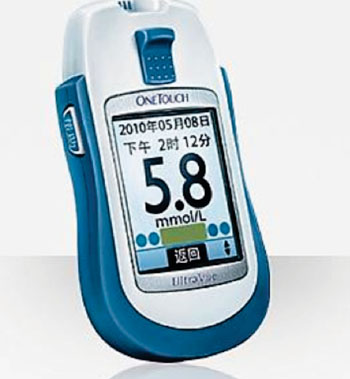POC Testing Compared to Automated Blood Glucose Analysis
By LabMedica International staff writers
Posted on 13 Sep 2016
Diabetes mellitus is a metabolic disease that is characterized by hyperglycemia and blood glucose (BG) levels are helpful for the diagnosis and treatment of diabetes and an important part of the management of diabetes.Posted on 13 Sep 2016
Point-of-care testing (POCT) is generally used by patients themselves or medical personnel to monitor BG. As it is simple to use and supplies rapid results, it might accelerate clinical decision-making and improve patients' prognosis.

Image: The OneTouch UltraVue POC blood glucose monitor (Photo courtesy of Johnson & Johnson).
Scientists at the Guangxi Medical University (Nanning, China) carried out a retrospective study comprising 162 volunteers (97 males and 65 females; median age, 47 years; range, 14 to 67 years). Blood samples were collected with anticoagulation tubes for which hematocrit values ranged between 34.5% and 54% and the range of glucose concentrations were 1.60–21.30 mmol/L. Each sample was divided into two parts; one was separated by centrifugation and measured by the central laboratory system, and the other was measured by the POCT system in whole blood.
The team tested three types of BG meter: They were the ACCU-CHEK Performa and the ACCU-CHEK Active (Roche Diagnostics, Basel, Switzerland), and the OneTouch UltraVue (Johnson & Johnson Medical Ltd, Shanghai, China). The clinical laboratory measurement system used the Glucose GOD-PAP method with a Hitachi 7600-120 analyzer (Hitachi Corporation, Tokyo, Japan) as a reference system.
The investigators showed that BG concentrations measured by venous whole blood was comparable with the reference method. Although the POCT can provide rapid measurement results, the type of specimen, interference factors, environmental conditions, and hematocrit may affect the results. The measurement accuracy of the POCT systems, being 94.9%, 92.6%, and 96.7% for ACCU-CHEK Performa, ACCU-CHEK Active, and OneTouch UltraVue, respectively, did not all meet the requirements. The same result was found for BG concentrations equal to or greater than 5.55 mmol/L (100 mg/dL). With BG concentrations of less than 5.55 mmol/l (100 mg/dL), the accuracy of all POCT systems meet the criteria.
The authors concluded that their study indicated that the POCT system could only be used as a screening test for continuous, qualitative, or semi-quantitative detection as a complement emergency measure to the central laboratory, instead of being used as a standard result in clinical diagnosis. If the POCT system is used in testing too low or too high BG concentrations in clinical diagnosis, it may mislead the diagnosis and treatment. The study was published on August 25, 2016, in the Journal of Clinical Laboratory Analysis.
Related Links:
Guangxi Medical University
Roche Diagnostics
Johnson & Johnson Medical
Hitachi Corporation













